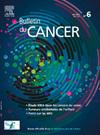Évaluation de la pertinence des outils de diagnostic de la dénutrition chez les patients atteints de cancer des voies aérodigestives supérieures
IF 0.8
4区 医学
Q4 ONCOLOGY
引用次数: 0
Abstract
Introduction
La dénutrition est un facteur pronostic majeur en cancérologie des voies aérodigestives supérieures. La Haute Autorité de Santé recommande plusieurs méthodes pour diagnostiquer la dénutrition. L’objectif principal de cette étude était de déterminer si les méthodes de diagnostics de dénutrition avant traitement appliquées par la diététicienne, l’enseignant d’activité physique adaptée et l’impédancemétrie étaient complémentaires ou redondants.
Méthode
Soixante-six patients âgés de dix-huit à 70 ans, atteints d’un cancer des voies aérodigestives supérieures et ayant bénéficié d’une évaluation nutritionnelle selon les trois méthodes, avant le traitement de leur cancer ont été inclus de manière rétrospective. L’âge moyen état de 54,9 ans. La localisation la plus fréquente était les cancers oropharyngés.
Résultats
Trente-quatre patients étaient dénutris au moment du diagnostic de leur cancer des voies aérodigestives supérieures selon au moins un des tests (52,3 %). Les spécificités des différents tests utilisés variaient entre 3,3 et 55,2 %, celles de chaque méthode (diététique, activité physique adaptée et impédancemétrie) entre 48,4 et 64,7 %. Les diagnostics de dénutrition par deux des trois méthodes ont été concordants dans 26,1 % à 38,5 % des cas et par les trois méthodes dans 2,9 % des cas de dénutrition (le diagnostic de dénutrition a été porté par les trois méthodes chez un seul patient).
Conclusion
L’utilisation combinée de l’évaluation par une diététicienne, un enseignant d’activité physique adaptée et de l’impédancemétrie offre une approche plus complète, complémentaire et non redondante pour le diagnostic de la dénutrition chez les patients atteints d’un cancer des voies aérodigestives supérieures, probablement généralisable à l’ensemble des patients atteints de cancer solide ou hématologique.
Introduction
Malnutrition is a major prognostic factor in head and neck cancers. The French National Authority for Health recommends several methods for diagnosing malnutrition. The main aim of this study was to determine whether the methods used to diagnose malnutrition prior to any treatment by the dietician, the adapted physical activity teacher and impedancemetry were complementary or redundant.
Method
Sixty-six patients aged 18 to 70 with head and neck cancer who had undergone nutritional assessment using the three methods prior to cancer treatment were retrospectively included. The mean age was 54.9 years. The most frequent location was oropharyngeal cancer.
Results
Thirty-four patients were malnourished at the time of diagnosis of their head and neck cancer according to at least one of the tests (52.3%). The specificities of the different tests used ranged from 3.3 to 55.2%, and those of each method (diet, adapted physical activity and impedancemetry) from 48.4 to 64.7%. The diagnosis of malnutrition by two of the three methods was concordant in 26.1% to 38.5% of cases, and by all three methods in 2.9% of cases of malnutrition (the diagnosis of malnutrition was made by all three methods in a single patient).
Conclusion
The combined use of assessment by a dietician, an adapted physical activity teacher and impedancemetry offers a more complete, complementary and non-redundant approach to the diagnosis of malnutrition in patients with head and neck cancer, which can probably be generalised to all patients with solid or haematological cancer.
[评估头颈部癌症患者营养不良诊断工具的相关性]。
简介:营养不良是头颈癌的主要预后因素。法国国家卫生局推荐了几种诊断营养不良的方法。本研究的主要目的是确定在营养学家、适应性体育活动教师和阻抗测量进行任何治疗之前用于诊断营养不良的方法是互补的还是多余的。方法:回顾性分析66例年龄在18 ~ 70岁的头颈癌患者,在癌症治疗前采用三种方法进行营养评估。平均年龄为54.9岁。最常见的部位为口咽癌。结果:34例患者在诊断为头颈癌时至少有一项营养不良(52.3%)。所使用的不同测试的特异性范围为3.3%至55.2%,每种方法(饮食、适应性身体活动和阻抗测量)的特异性范围为48.4%至64.7%。三种方法中两种对营养不良诊断的一致性为26.1% ~ 38.5%,三种方法对营养不良诊断的一致性为2.9%(三种方法均对同一例患者进行了营养不良诊断)。结论:营养学家、适应性体育活动教师和阻抗测量相结合的评估为头颈癌患者营养不良的诊断提供了一种更完整、互补和非冗余的方法,可能推广到所有实体或血液系统癌症患者。
本文章由计算机程序翻译,如有差异,请以英文原文为准。
求助全文
约1分钟内获得全文
求助全文
来源期刊

Bulletin Du Cancer
医学-肿瘤学
CiteScore
1.90
自引率
16.70%
发文量
224
审稿时长
37 days
期刊介绍:
Without doubt, the ''Bulletin du Cancer'' is the French language publication of reference in the field of cancerology. Official organ of the French Society of Cancer, this journal covers all the information available, whether in the form of original articles or review articles, but also clinical cases and letters to the editor, including various disciplines as onco-hematology, solids tumors, medical oncology, pharmacology, epidemiology, biology as well as fundamental research in cancerology. The journal proposes a clinical and therapeutic approach of high scientific standard and regular updates in knowledge are thus made possible. Articles can be submitted in French or English.
 求助内容:
求助内容: 应助结果提醒方式:
应助结果提醒方式:


